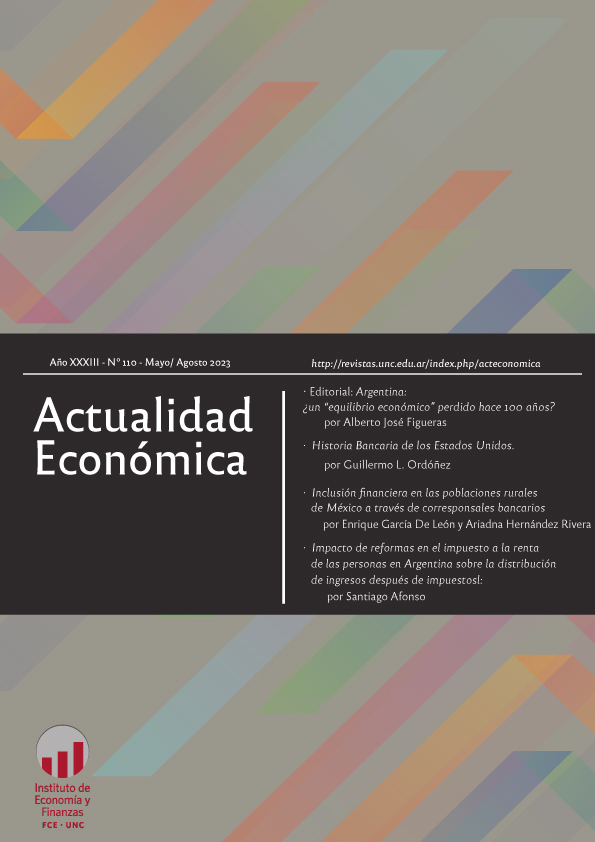Impact of income tax reforms in Argentina on after-tax income distribution
Keywords:
Income Inequality, Income Tax, InflationAbstract
We study income inequality dynamics in Argentina over the 1996-2015 period, before and after taxes on labor and social security contributions. After the 2001-2002 crisis, the country experienced changes in its economic structure, labor market institutions and fiscal policies, with an increase in the size of the public sector. The personal income tax contributed to that expansion by growing in the number of taxpayers and effective rates. The rise was not monotonic, but rather affected by the political cycle. The document describes the historic evolution of the tax’s parameters and its main reforms. We then use administrative payroll data of registered employees to simulate tax liabilities and therefore calculate inequality indicators. We find that after-tax income inequality has a decreasing tendency, particularly towards the end of the period. The distortive tax reforms motivated by the elections create limited but perceptible regressions on the inequality indicators.
Downloads
References
AFIP. (2020): “Declaración En Línea (Form. 931).,”
Afonso, S. (2023): Diagnóstico del sistema tributario argentino, Working Paper, UNDP.
Afonso, S., and S. Galiani. (2018): “Impuestos en Argentina,” Foco Económico, http://focoeconomico.org/2018/01/17/impuestos-en-argentina/, Accessed 06/20/2021.
Afonso, S., S. Galiani, and M. Tappatá. (2018): La Reforma Tributaria Argentina de 2017,Ministerio de Hacienda, 94.
Allcott, H., B. Lockwood, and D. Taubinsky. (2018): Ramsey Strikes Back: Optimal Commodity Taxes and Redistribution in the Presence of Salience Effects, NBER Working Papers, . NBER Working PapersNational Bureau of Economic Research, Inc, https://ideas.repec.org/p/nbr/nberwo/24233.html.
Alvaredo, F., G. Cruces, and L. Gasparini. (2018): “A short episodic history of income distribution in Argentina,” Latin American Economic Review, 27, 7, DOI:10.1007/s40503-017-0048-3.
Aresco, J. A. (2021): “Estudio de Contexto Sociopolítico AMBA Sobre El Impuesto a Las Ganancias.,”
Atkinson, A. B., and J. E. Stiglitz. (1976): “The design of tax structure: Direct versus indirect taxation,” Journal of Public Economics, 6, 55–75, DOI:10.1016/0047-2727(76)90041-4.
Besley, T., and T. Persson. (2013): “Chapter 2 - Taxation and Development,” in Handbook of Public Economics, ed. by Auerbach, A. J., R. Chetty, M. Feldstein, and E. Saez. . handbook of public economics, vol. 5Elsevier, 51–110, DOI:10.1016/B978-0-444-53759-1.00002-9.
Blanco, J., B. Diaz de Astarloa, A. Drenik, C. Moser, and D. Trupkin. (2021): “The Evolution of the Earnings Distribution in a Volatile Economy: Evidence from Argentina,” CEDLAS Working Papers, , DOI:10.2139/ssrn.3779632.
Cerimelo, M. (2021): “Dinámica de ingresos asalariados en Argentina: un estudio sobre la base de registros administrativos,” CEDLAS Working Papers, , 28.
Díaz Bazán, T. (2011): “Medidas de desigualdad a partir de datos impositivos,”Universidad Nacional de La Plata, DOI:10.35537/10915/31895.
Fernández Felices, D., I. Guardarucci, and J. Puig. (2021): “Incidencia distributiva del sistema tributario argentino,” Estudios económicos, 33, 23–46, DOI:10.52292/j.estudecon.2016.716.
Gasparini, L. C. (1998): “La Incidencia Distributiva Del Sistema Tributario Argentino,” in La Reforma Tributaria en la Argentina, 2 Vol.FIEL.
Gerchunoff, P., and M. Rapetti. (2016): “La economía argentina y su conflicto distributivo estructural (1930-2015),” El Trimestre Económico, 83, 225–72, DOI:10.20430/ete.v83i330.199.
Gómez Sabaini, J. C., J. J. Santieri, and D. A. Rossignolo. (2002): La equidad distributiva y el sistema tributario: un análisis para el caso argentino, . Serie Gestión pública 20Santiago de Chile: Naciones Unidas, CEPAL : Instituto Latinoamericano y del Caribe de Planificación Económica y Social-ILPES, Dirección de Gestión Pública y Regulación.
Jensen, A. (2019): Employment Structure and the Rise of the Modern Tax System,National Bureau of Economic Research, DOI:10.3386/w25502.
Kleven, H. J., and M. Waseem. (2012): “Behavioural Responses to Notches. Evidence from Pakistani Tax Records.,” 58.
Mirrlees, J. A., and S. Adam, eds. (2011): Tax by Design: The Mirrlees Review, Institute for Fiscal Studies.
Observatorio de Empleo y Dinámica Empresarial. (2018): “Manual de La Muestra Longitudinal de Empleo Registrado,”Ministerio de Trabajo, Empleo y Seguridad Social (MTEySS), http://www.trabajo.gob.ar/downloads/estadisticas/basesusuarias/mler/Manual_muestra_longitudinal.pdf.
Rossignolo, D., and J. P. Jiménez. (2019): “Concentración del ingreso y desigualdad según registros tributarios en América Latina: el caso de la Argentina,” 39.
Tommasi, M., and P. T. Spiller. (2007): “The Institutional Foundations of Public Policy in Argentina,” 255.
Tortarolo, D., G. Cruces, and V. Castillo. (2019): It Takes Two to Tango: Labor Responses to an Income Tax Holiday in Argentina, http://economics.dtortarolo.com.ar/jmp-tortarolo.pdf.
Downloads
Published
Issue
Section
License

This work is licensed under a Creative Commons Attribution-NonCommercial-NoDerivatives 4.0 International License.
Those authors who have published with this journal, accept the following terms:
Authors will conserve their copyright and guarantee the magazine the right of first publication of their work, which will be simultaneously subject to the Creative Commons Attribution-NonCommercial-NoDerivative 4.0 International License that allows third parties to share the work as long as the author and first publication of this magazine are indicated.
Authors may adopt other non-exclusive license agreements to distribute the published version of the work (e.g., deposit it in an institutional telematic archive or publish it in a monographic volume) provided that the initial publication in this journal is indicated.
Authors are allowed and encouraged to disseminate their work through the Internet (e.g., in institutional telematic archives or on their website) before and during the submission process, which may lead to interesting exchanges and increase citations of the published work. (See The effect of open access)









